8. Goodfellas (Martin Scorsese, 1990)
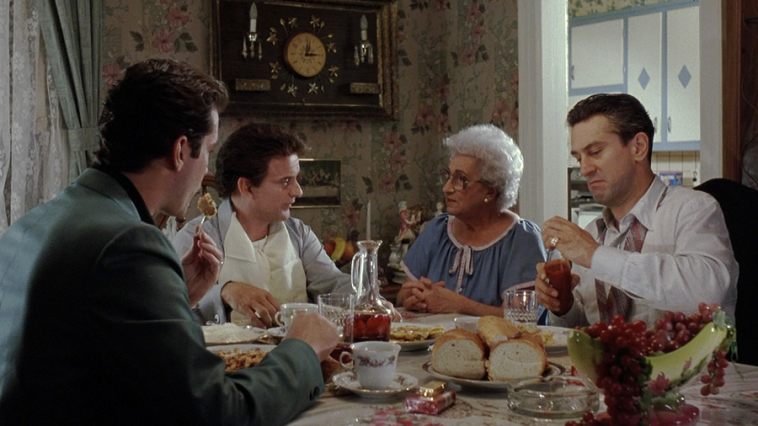
What separates a good film from a great one is, mostly, the display of conventional situations disrupting an unconventional narrative, much like they do in real life. How these disruptions are manipulated creates great opportunities for character development and an intimate outcome that causes the viewer to become more emotionally invested.
It just goes to show that a scene about a good old-fashioned, Italian-American mother making her son and his friends dinner works well in a film about viscious gangsters. When they appear unexpectedly, very late at night and all blood-spattered at her house, the adorable old lady offers to prepare them a meal and does not take no for an answer. She remains blissfully unaware and they chat about pleasant topics, like her painting.
Most interestingly, the old lady that clearly steals the show, seeming truly an unsuspecting family member rather than an actress, does so for good reason; she is director Martin Scorsese’s own mother.
7. Lars and the Real Girl (Craig Gillespie, 2007)
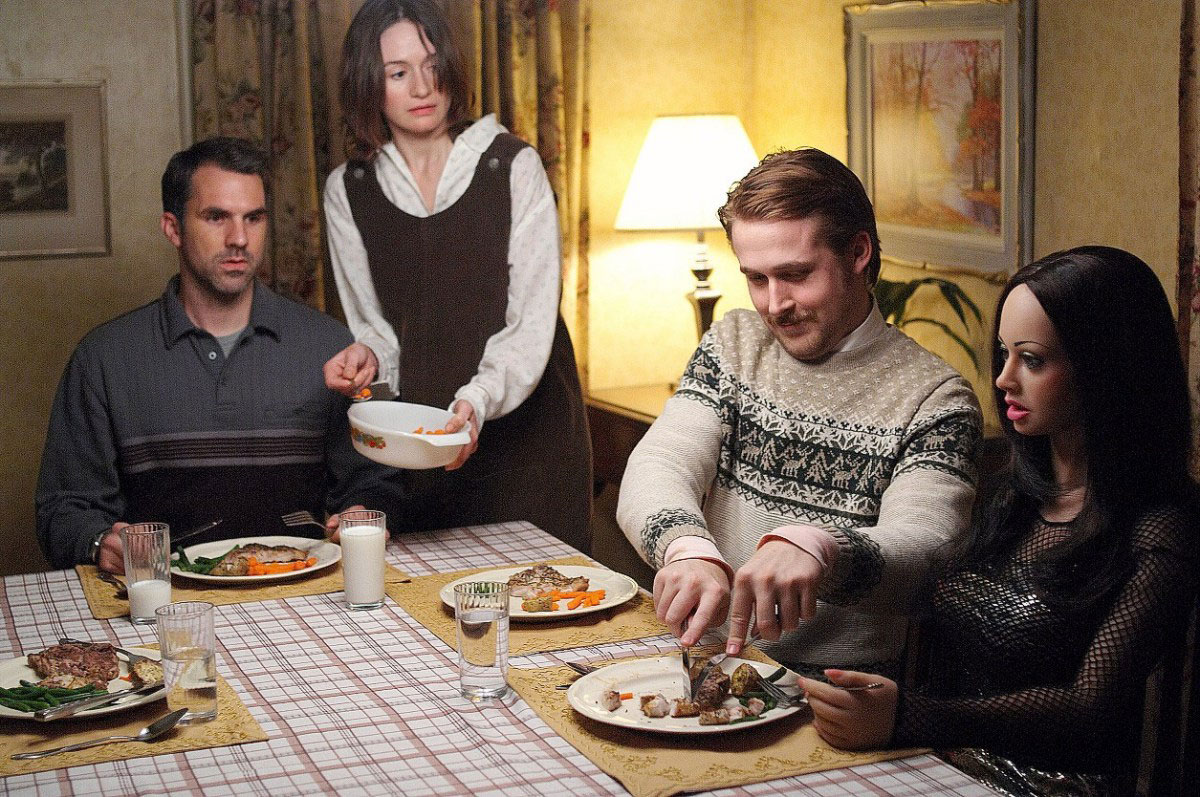
A strange premise for a movie with Ryan Gosling as the protagonist of the same name, Lars and the Real Girl tells the tale of one man striking up a relationship with a life-sized doll.
Gosling has proved his acting chops several times but to see the handsome actor as awkward and shy as here (and as believable) is quite the feat.
The scene that qualified for this list is of him rolling his “girlfriend” in a wheelchair to his brother and sister-in-law’s doorstep. Their reaction is priceless, as they are thrown into a hilarious and mortifying situation. Certainly the last thing anyone would expect after hearing about somebody’s foreign, handicapped, deeply religious special someone is for them to turn out to be made of silicone.
The couple struggles to maintain their composure and not hurt Lars’s feelings, as they see him more excited than ever, but the empty stare of the doll’s expressionless face would prove too much for anyone.
Needless to say, dinner ends up a proper Waterloo as they argue in the kitchen. However, the scene is very representative of the delicate and thoughtful way the film deals with its material, not resorting to cheap comedy and highlighting the difference a community’s support can make in a person’s life.
6. Pulp Fiction (Quentin Tarantino, 1994)
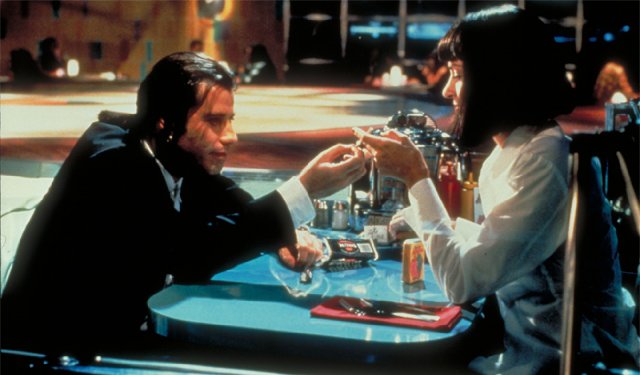
There was a lot of competition about which dinner scene from this Tarantino flick should make it into the list, but in the end the chemistry between John Travolta and Uma Thurman proved irresistible.
Vincent Vega, the reluctant bodyguard/babysitter of spoiled cokehead turned trophy wife Mia Wallace, accompanies her to a celebrity-themed diner where they trade quips over 5-dollar milkshakes and the like. After dinner follows dancing to Chuck Berry’s “You Never Can Tell”, in one of the movie’s most iconic scenes and soundtrack moments.
The characters talk about everything and nothing at the same time, so this is definitely not a plot advancing or even important conversation. However, the viewer’s attention remains fixed as trademark Tarantino one-liners are tossed around and the charm of the two protagonists’ every movement keeps you under its spell.
5. Beetlejuice (Tim Burton, 1988)
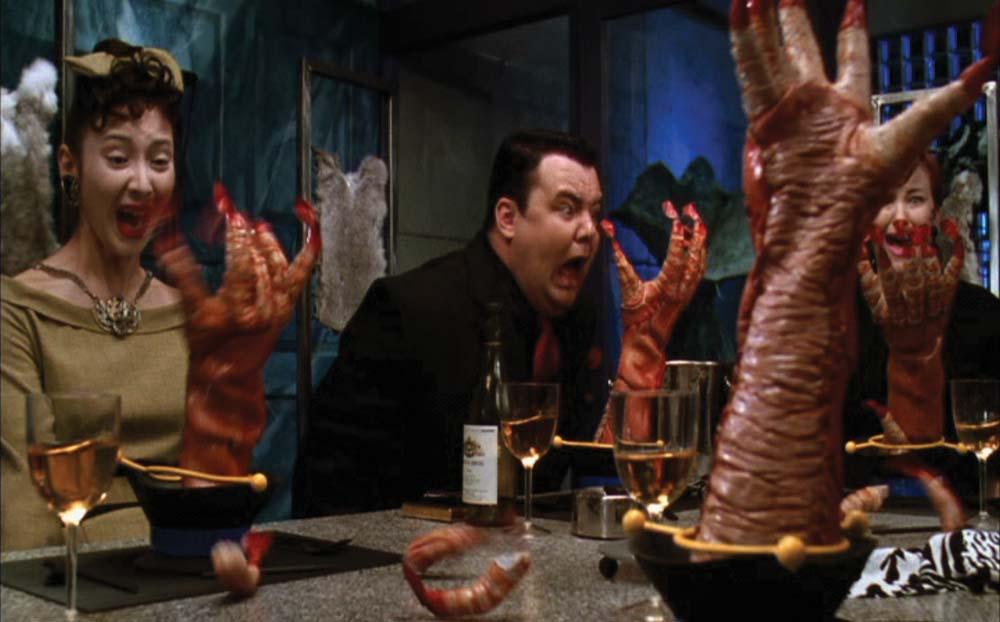
Sometimes people get way more than they expected out of a boring, pretentious dinner. Who can forget the moment when annoying Delia Deetz breaks into uncontrollable song? Consequently, her fellow diners unwillingly join her and they all dance around the table to the “Banana Boat Song”, just before having their faces grabbed by cocktail shrimp-hands.
Almost nobody could make this absurdity up, except notorious mr. Tim Burton, creator of the beloved 90’s classic. The plot is about a dead couple that try to get rid of their house’s new owners and befriend a brooding young girl in the process. Michael Keaton, giving a lovely, zany performance, appears as the title character and wreaks havoc in every possible way.
4. American Beauty (Sam Mendes, 1999)
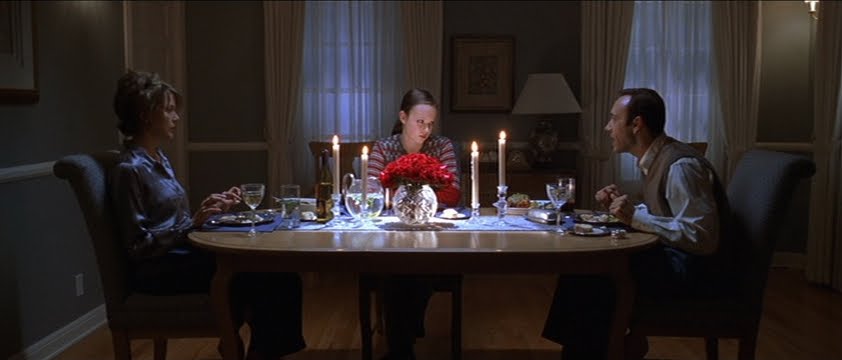
There is little that can be said about this extremely well-known film, Best Picture Academy Award winner and the second addition to this list directed by Sam Mendes. The first image that jumps to everyone’s mind is, admittedly, that of Mena Suvari being in a bathtub and covered with rose petals during Kevin Spacey’s character’s pervy fantasies.
There are many more memorable scenes, though, like Wes Bentley’s tender performance as the shy boy next door, the empty bag tumbling in the wind and, of course, the dinner scene.
Featuring the famously improvised inspiration of Spacey, an actor as excellent as he is disturbing in his portrayals of dark characters, the seemingly peaceful, dignified family meal is violently interrupted by the father’s outburst.
Lester Burnham has had enough of his wife’s incessant nagging about him leaving his job and, generally, of his life. So he smashes the plate of the asparagus in question on the wall, getting the genuine reaction of his costars (he was supposed to drop it to the floor). When you learn that this is only one of his improvisations, it really emphasizes the importance of great acting.
3. Oldboy (Chan-wook Park, 2003)
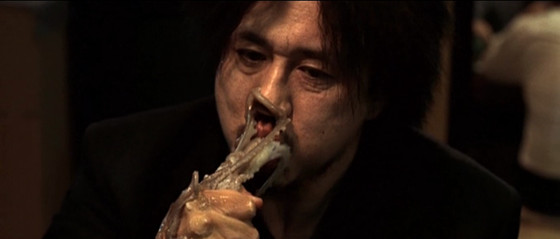
Park Chan-wook and his Vengeance Trilogy are appreciated by Korean cinema enthusiasts and pretty much any movie goer worth his salt. The middle installment, Oldboy, is generally considered the best of the three.
Oh Dae-su has been imprisoned for 13 years for reasons and by people unknown to him. All these years he sustained on a diet of the same junk food for every meal. As expected, one of the first things he does as soon as he is set free is go somewhere where he can eat something different at last.
He takes this yearning a bit too far, though, as he asks for and devours an actual, live octopus whole, wriggling tentacles and all. This is not an unusual delicacy in Korea, but it is served sliced for obvious convenience reasons.
The characteristic scene has to be viewed to be appreciated in all its distusting glory. However, it is relevant to the spirit of the rest of the movie and the actor’s performance is admirable, as he is a buddhist and had to pray after the consumption of the animal.
2. American History X (Tony Kaye, 1998)
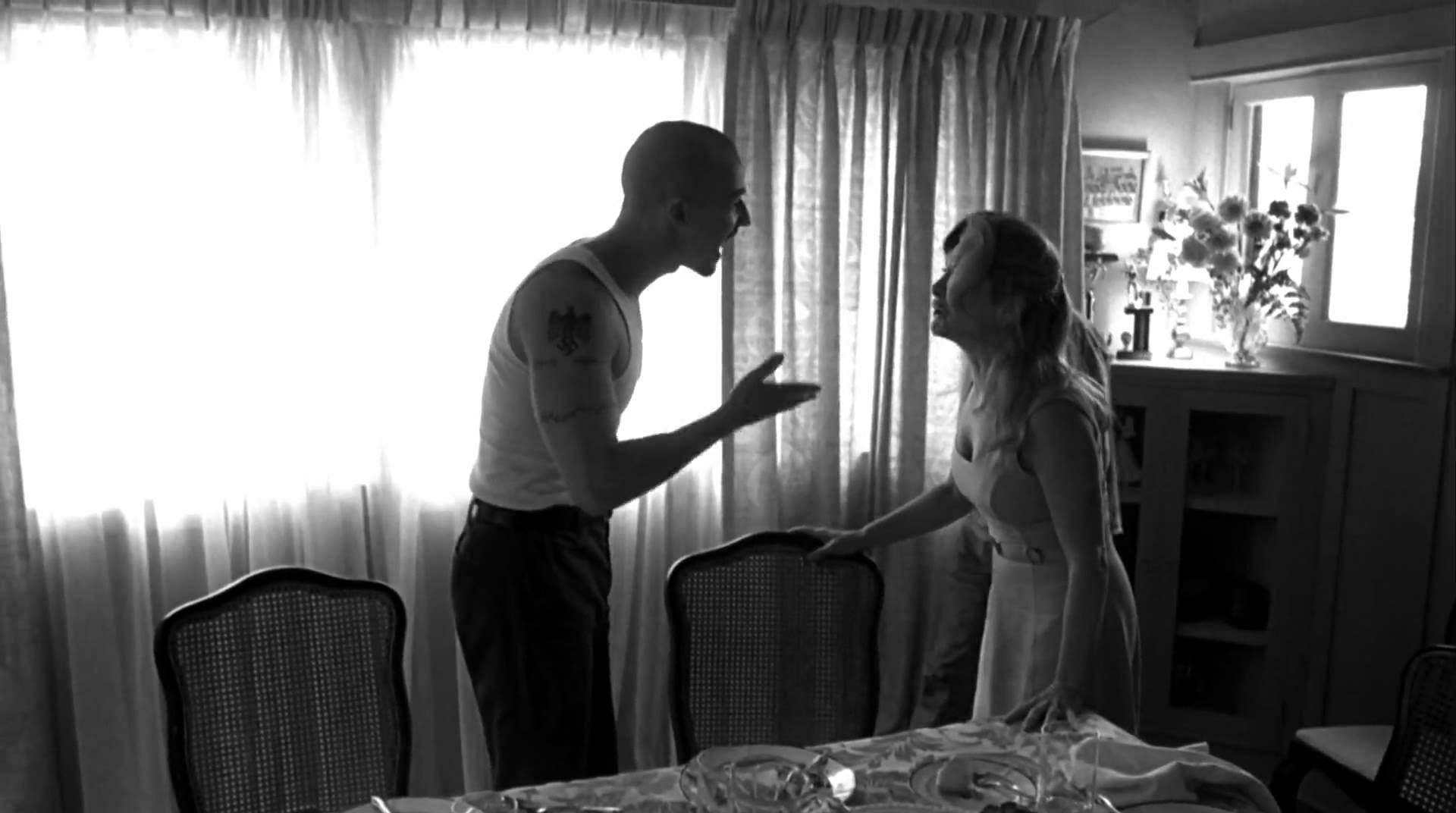
American History X is a film with a controversial subject; a white supremacist gang leader’s rise and fall due to his own beliefs, the crimes he committed and the effort to prevent his brother from making the same mistakes.
It makes sense that this kind of socio-political beliefs create very uncomfortable dinner conversations that could easily turn into heated arguments. That is exactly the case in question, where central character Derek, seconded by his girlfriend, confronts his mother’s Jewish new boyfriend. The scene crescendoes with Derek’s violent outburst, attacking the, in his opinion, unsufferably progressive man that dared confront him and flaunting his swastika tattoo.
This scene correlates with another, put much earlier in the film’s timeline, where we get to see the family having dinner before the father died. The way his conservative, racist beliefs had already started seeping into younger Derek’s mind is obvious, as well as the way the cycle of hate is perpetuated.
1. Festen (Thomas Vinterberg, 1998)
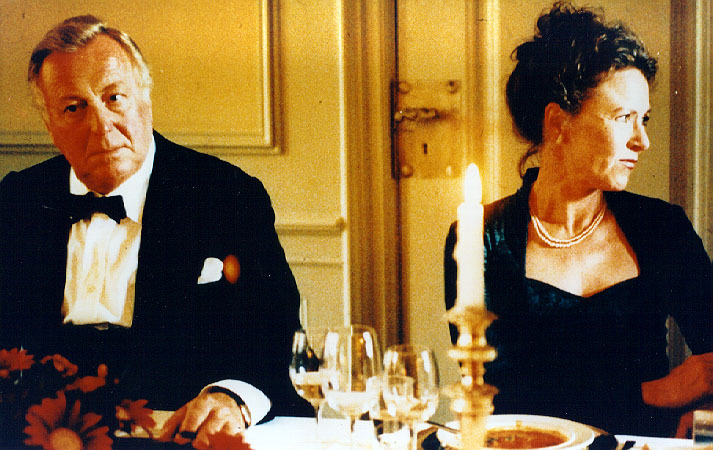
One of the first films to be created within the famous “Dogme 95” style, Festen’s director Thomas Vinterberg co-wrote the Dogme manifesto with Lars von Trier. He has since confessed to breaking some rules by covering a window (and thus altering the strict, raw realism that this directing style commands) but the film remains an archetype.
It is the patriarch’s 60th birthday and all the family has gathered in a castle to celebrate. His eldest daughter has recently committed suicide so he asks his son to say some words in her honour because he is sure he would break into tears. He agrees and has actually prepared two speeches. He asks the father to pick one and announces that it is the Speech of Truth.
As everyone seated around the table politely laugh, he starts to speak and their mirth soon turns to horror as the family’s darkest secrets and history of abuse are laid out.
The unforgettable plot was inspired by a story shared on a radio broadcast by one caller. Vinterberg was among the listeners and many years later got to meet that caller. His story proved to be fictitious albeit in its turn inspired by another woman’s speech on a Christmas family dinner.
Author Bio: Dina Kelesi currently lives in Athens, Greece. She spends most of her time making or withholding snarky remarks and memorizing useless, interesting information.